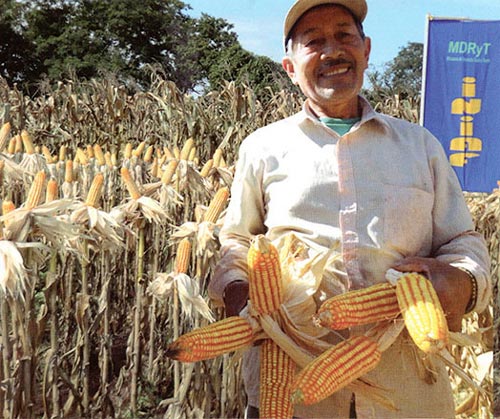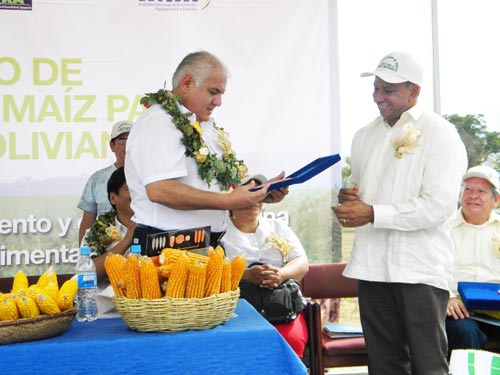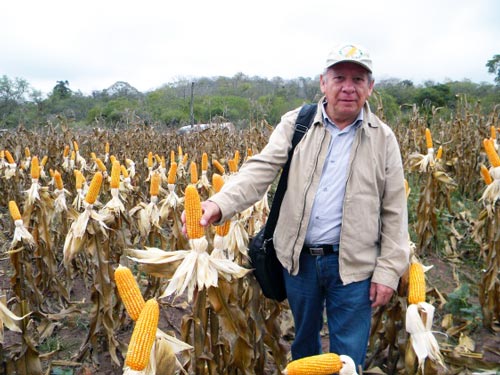 Bolivia’s National Institute for Agricultural, Livestock and Forestry Innovation (INIAF), in collaboration with CIMMYT, released two new maize hybrids, INIAF H1 and INIAF HQ2, targeting drought-prone areas with high production potential. The release was announced at an event held on 13-14 June 2013 in Villa Montes and Yacuiba.
Bolivia’s National Institute for Agricultural, Livestock and Forestry Innovation (INIAF), in collaboration with CIMMYT, released two new maize hybrids, INIAF H1 and INIAF HQ2, targeting drought-prone areas with high production potential. The release was announced at an event held on 13-14 June 2013 in Villa Montes and Yacuiba.
The new releases are single-cross hybrids derived from CIMMYT lines. INIAF H1 is a yellow flint hybrid with good lodging resistance and excellent husk cover; INIAF HQ2 is a yellow semi-dent hybrid with high protein content (quality protein maize, QPM) and moderate drought tolerance. Both were tested at Villa Montes, where they competed favorably with two widely sown commercial checks, yielding 7 t/ha despite the low (352 mm) rainfall during the growing season.
While Bolivia is self-sufficient in maize production with about 300,000 ha sown to maize and an average yield of 3.3 t/ha, climate change is starting to impact the agricultural sector just like in other Latin American countries. Weather conditions during the current crop season have been unfavorable for production due to persistent drought, and last week the government declared the region of Chaco, where 80% of the country’s maize is produced, a natural disaster area.

In the light of the challenges, Rubén Vaca, Sector Executive of Villa Montes, who led the event during the first day, congratulated INIAF on its achievements and noted their potential for increasing the profitability of maize production. Similar sentiment was expressed by Nemesia Achacollo, Minister of Land and Rural Development, and José Sosa, Minister of Energy and Hydrocarbons, who attended the event in Yacuiba on day two. Achacollo applauded the release of the hybrids and announced that “the Ministry is allotting 2 million US$ to INIAF to support their maize program.” As the Ministry of Energy and Hydrocarbons is also involved in agriculture, Sosa stated that the urea factory being built in Cochabamba will support the development of Chaco Tarijeño and the country as a whole. Marcial Rengifo, Sector Development Executive of Chaco Tarijeño in Yacuiba, then stressed the importance of the hybrids for Chaco farmers, and Jemy Gonzales, manager of the National Seed Company, committed to multiplying all the hybrids released by INIAF in the future to ensure that high quality seed is accessible to farmers in a timely fashion and at a reasonable price.
After Achacollo presented a hybrids release certificate to INIAF director general Gabriel René Hoyos Bonillas, the coordinator of INIAF’s Maize Program, Tito Claure, thanked everyone present and asked that INIAF’s collaboration with CIMMYT be maintained, adding that he “would join forces with all the national institutions involved in maize production.”
“We must promote QPM, which – due to its superior nutritional qualities – benefits both the people who consume it directly as well as pig farmers,” said Luis Narro, CIMMYT maize breeder and focal point for South America. Narro then encouraged INIAF to adopt doubled haploid technology to reduce the time required to develop new hybrids and indicated that the GreenSeeker handheld sensor could be used to optimize nitrogen fertilization in maize crops.

“The CIMMYT-INIAF collaboration that led to the hybrids release is part of CIMMYT’s regional efforts conducted jointly with an improved germplasm evaluation network in the lowland tropics of Latin America,” said Félix San Vicente, CIMMYT maize breeder for Latin America. “We are ready to strengthen these links in the future in order to be able to handle the negative impacts of climate change on the Chaco region in Bolivia,” he added.
At the end of the event, Narro and San Vicente received awards from the Bolivian authorities in recognition of their inter-institutional collaboration and joint successes.
 Climate adaptation and mitigation
Climate adaptation and mitigation